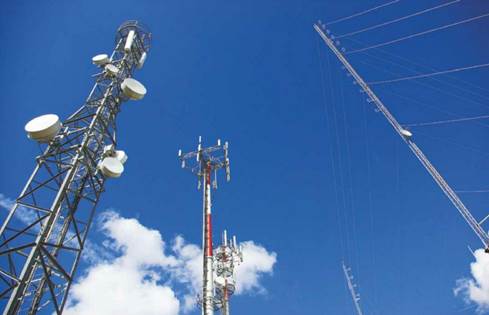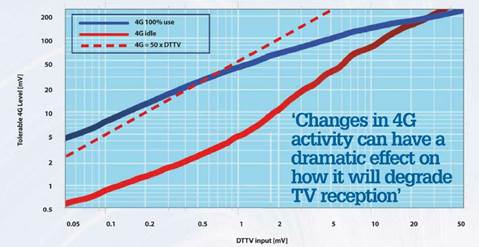Jim L. investigates the impact the
new 4G mobile networks will have on Freeview reception, and who will be paying
the price
The government has been boasting for years
about a ‘digital dividend’ and part of the bright vision for a high-tech future
are 4G mobile networks. With the Everything Everywhere (aka EE) 4G network
already up and running and others set to follow later in 2013, the current
plans may be offering a ‘jammed tomorrow’ for millions of Freeview TV viewers…
In the period from October 2012 to October
2013 the channels will be re-allocated in many parts of the UK to ‘clear’ two
parts of the spectrum. What have been UHF TV channels 61 - 69 will be handed
over to 4G mobile service providers. In principle, this is fine, but the devil
is in the details.

4G
network transmitting from antenna farms like this could block your TV reception
It is worth nothing that the final details
are still under discussion, but something like the arrangements described look
like being the settled outcome after some years of argument… erm negotiation.
The plan provides a 1 MHz ‘guard gap’ which
no-one should use. The 4G allocation just above this – i.e. nearest TV channel
60 are for 4G base stations to send information out to 4G mobile devices (i.e.
downlinks). These will occupy the band space from 791 MHz upwards.
The 1MHz gap will ring loud alarm bells in
the minds of experienced radio engineers. It puts the 4G transmissions very
close to DTTV reception. The power levels for 4G base station transmissions
will also be high compared to older generations of mobiles and the combination
represents a serious threat to DTTV reception.

Spectrum
by the end of 2013

4G
WRC07 changes
The effects of 4G interference
Mark Waddell is a lead research engineer at
the BBC who has made a great number of measurements on domestic DTTV equipment
subjected to 4G-like interference. He kindly gave permission for us to use the
published details to help explain the likely consequences. For clarity we have
picked out one receiver as an example.
The graph below shows how large a 4G
‘challenge’ could be tolerated for various input levels. The blue line
represents when the base station is sending as much data as it can to as many
users as it can handle. The red line shows what happened when the base station
was idle (i.e. no actual 4G use). The broken red line indicates where the 4G
voltage would be 50 times the DTTV signal voltage.

Impact
of 4G interference on a DDTV receiver
The most obvious point is that changes in
4G activity can have a dramatic effect on how much it will degrade DTTV
reception. This complicates the situation because reception may come and go as
the demand on the local 4G base station fluctuates and could result in an
engineer call out to investigate the problem of a set that doesn’t work only to
face the classic behavior where the problem has evaporated by the time the
engineer arrives! The result is a call-out charge, the tradesman leaves…and the
problem comes back again once he has gone. The details will vary from house to
house, making it frustrating for those affected.
Focusing on when the 4G base station is
working 1100 percent – i.e. the ‘best’ situation at low 4G interference
voltages levels the receiver can reject the interference fairly effectively.
However, at higher levels of interference, the ability of the receiver to cope
collapses. If the 4G interference is as high as 100 mV we find that the
receiver needs around 20 mV of DTTV signal.
This behavior is a classic response for a
system being driven into nonlinearity be excessive input signal levels. It
shows that we can’t rely on the RF filtering implemented in existing domestic
equipment, and those living near a 4G base station may be unable to watch even
a strong DTTV signal. The situation becomes worse when the 4G usage is less
than 100 percent and in this situation 4G can become a very effective ‘jammer’
for DTTV reception!
The bulk of TV reception equipment in UK
homes has been designed and sold during a time when interference like this was
not expected to be widespread. So it will hardly be a surprise if it cannot
cope.
The magician’s wand?
The proposals include a ‘mitigation’
strategy, mainly based on handing out filters to households that are affected.
This seems an odd take on the ‘polluter pays’ principle. The idea being that
the 4G companies will pay for the filters. Yet the ‘pollution’ is actually
their transmissions being so powerful and so near to established TV services.
You might think it would be more
appropriate for the 4G transmission powers and channel allocations to be
restricted to ensure that far fewer people are adversely affected. This seems
much like someone being allowed to make a bit of a mess provided they also hand
out a few brooms.
Even assuming that filters are handed out,
there is an additional problem that seems not to have had much consideration.
What about those who move into an affected area particularly into newly built
houses in the future? Should we expect the 4G providers to have a perpetual
obligation to hand out ‘free’ filters to such people who may find that none are
in place when they set up home? Or is the assumption that all new DTTV sets and
boxes from the end of 2012 onwards will have 4G filters incorporated by the
set-makers? If the latter is the presumption, then it seems prudent to wonder
how quickly such designs will come to market, and what impact this may have on
the cost of new DTTV sets/boxes. How quickly will they replace all earlier
designs? Another hidden ‘cost’ is also the impact on the second-hand value of
existing sets and boxes because they are not ‘4G hardened’.
Snags and desirable changes
Having ‘ch59’ and ‘ch60’ filter designs has
clearly been driven by allocating a tiny guard gap between DTTV and 4G. The
failure to make a single filter design adequate is nature’s way of telling us
that 1 MHz is impractically small for the intended 4G powers.
It seems to me that it would be more sensible
to have a wider frequency gap between DTTV and 4G. This could be done by either
changing the DTTV allocations to leave ch60/60- unused, or increase the guard
gap to at least 5MHz.
Either option would reduce the costs and
improve the performance of the required filtering. Given the ‘polluter pays’
principle, it would seem that the onus should be the latter option unless the
former is easily feasible and does not pose a difficulty for TV coverage.
As it stands, though, the current 4G plans
look uncomfortably like a ‘cunning plan’ to use 4G as a stealth jamming system
in order to push people into abandoning DTTV and pay for costly alternatives.